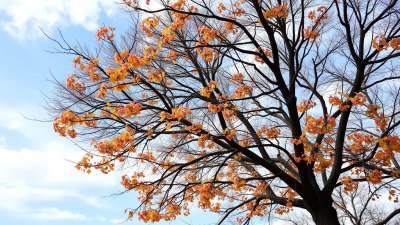What Makes the Breeze Feel So Refreshing After Winter
Discover the science behind the refreshing breeze after winter. Learn why it feels invigorating as seasons change.

Image by sergeycauselove on Freepik
As winter gradually recedes, the arrival of spring brings with it a distinctive change not only in nature but also in our sensory experiences. One of the most noticeable and inviting aspects of this transition is the refreshing breeze that sweeps through the air. After the long, cold months of winter, this gentle caress evokes feelings of rebirth, warmth, and hope for longer days and blooming landscapes. But what exactly makes this breeze feel so refreshing?
The Science of Temperature Change
One of the primary factors that contribute to the refreshing nature of the spring breeze is the change in temperature. Throughout winter, the air is generally cold and dry, often accompanied by freezing temperatures that make outdoor excursions less appealing. However, as spring approaches, the sun’s position shifts, gradually warming the earth's surface. This warming creates a distinct difference between the cold air that lingered during winter and the relatively warmer air that begins to circulate.
When this warmer air mixes with cooler air, it creates a refreshing breeze that can feel invigorating against the skin. The sudden change in temperature can stimulate nerve endings and receptors in our skin, activating our senses and enhancing our perception of the moment. This contrasts sharply with the cold, biting winter winds, which often feel harsh and uninviting.
Humidity and Moisture Levels
Another contributing element that makes the breeze feel refreshing after winter is the change in humidity and moisture levels in the air. During winter, air often becomes dry, creating an environment that can feel harsh on the skin and respiratory system. As spring approaches, warmer temperatures lead to increased evaporation from bodies of water, soil, and plants, introducing moisture back into the environment.
This revitalized humidity can make the spring breeze feel softer and more nurturing, as it carries with it a hint of moisture. The combination of warmth and humidity can rejuvenate our bodies, making outdoor activities much more enjoyable. It can even enhance our sense of smell, as humid air helps to carry scents more effectively, allowing us to breathe in the fresh aroma of blooming flowers and newly sprouted grass.
Connection to Nature and Seasonal Changes
Perhaps one of the most beautiful aspects of the refreshing spring breeze is its connection to the cyclical nature of seasons. After a period of dormancy, spring signals a time of renewal and growth. The arrival of the breeze often coincides with the sight of budding trees, blooming flowers, and the sounds of birds returning from their winter migrations. This sensory shift can create a deep emotional connection, evoking feelings of joy, optimism, and a renewed appreciation for life.
The gentle breeze serves as a reminder of the transitory nature of seasons, prompting us to reflect on our own personal growth and renewal. This emotional release can feel particularly poignant after the challenges and hardships of the winter months, allowing us to fully embrace the warmth, color, and vibrancy of the world around us.
Environmental Factors and Wind Patterns
The environmental factors and wind patterns also play a significant role in the refreshing quality of the breeze that heralds spring. As weather systems shift with the changing seasons, airflow patterns undergo transformations. In winter, colder air is typically dense and stagnant, while spring introduces various weather fronts that can alter wind patterns.
These shifts often result in breezes that carry scents, sounds, and temperatures from different environments. For instance, a spring breeze might originate from a nearby ocean or lake, bringing a salty, invigorating freshness that contrasts sharply with the dry, frigid air of winter. Additionally, spring winds tend to be more variable, presenting a delightful unpredictability that further adds to the excitement surrounding the change of seasons.
Psychological Effects of Spring
The psychological effects of spring cannot be overstated. Research has shown that as the seasons change from winter to spring, people's moods tend to improve. The longer days and increased sunlight play significant roles in enhancing mood and well-being. This positive shift aligns perfectly with the refreshing qualities of the spring breeze.
For many, the simple act of stepping outside to feel that gentle breeze can lift spirits and create a sense of energy and enthusiasm. This is partly due to the increase in serotonin levels that occurs with greater sun exposure. When we step into a spring breeze, we often feel invigorated and alert, ready to embrace new opportunities and experiences that the warmer weather brings.
The Role of Aromas and Scents
The spring breeze is not just a feel; it has an olfactory character that contributes significantly to its refreshing nature. As the landscape begins to awaken from its winter slumber, a plethora of aromas become prominent. From blooming flowers to fresh-cut grass, these scents are carried by the breeze, enhancing our outdoor experience.
The olfactory senses are deeply tied to emotions and memories; thus, the smells associated with spring can evoke nostalgia for past seasons and experiences. A whiff of a lilac blossom in the air or the earthy scent of rain-soaked soil can transport us back to cherished times, further deepening our emotional connection to the season.
Health Benefits of Spending Time Outdoors
Enjoying the refreshing breeze of spring is not merely about sensory pleasure; it has significant health benefits, too. Time spent outdoors contributes to overall physical and mental well-being. Sunshine, fresh air, and the opportunity to engage in physical activity can dramatically improve mood and health.
Research has shown that spending time outdoors can reduce stress, anxiety, and feelings of depression. The combination of warm temperatures, fresh air, and the refreshing nature of the spring breeze encourages people to engage in outdoor activities—walking, cycling, gardening, or simply enjoying a picnic on the ground. This active lifestyle associated with spring is a natural antidote to the hibernation that often characterizes winter.
The Delight of Outdoor Activities
The arrival of spring and the associated refreshing breezes create an ideal environment for various outdoor activities. People are naturally drawn outside, eager to take advantage of the warmer temperatures. The gentle spring breeze adds an element of comfort that makes activities enjoyable. Outdoor sports, social gatherings, and family outings become infused with a sense of freedom, movement, and vitality.
Gardening, for instance, becomes a therapeutic escape that encourages physical activity and creativity, while adventures such as hiking and biking become invigorating endeavors enhanced by the fresh, clean air. The sense of community rises as parks and recreational spaces fill once more with laughter, engagement, and shared experiences, creating a positive atmosphere that encapsulates the spirit of the season.
In essence, the refreshing breeze we experience after the cold, rigid winter months serves as a reminder of the beauty and vibrancy of life. Through physiological changes, emotional experiences, and environmental factors, we find joy and revitalization as nature awakens from its slumber. The spring breeze is more than just a change in the weather; it symbolizes hope, renewal, and the promise of new beginnings. When we take a moment to pause and feel that breeze upon our skin, we are reminded of the interconnectedness of our bodies, our surroundings, and the seasons of life.











